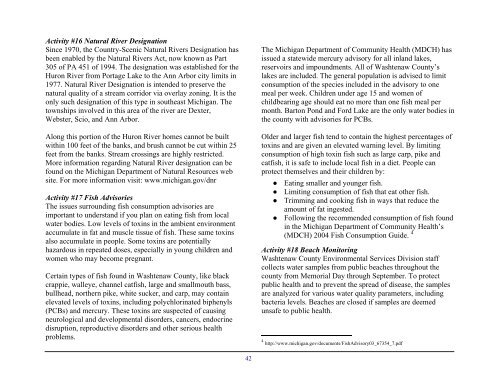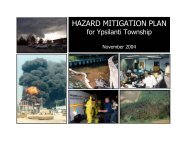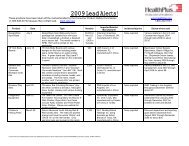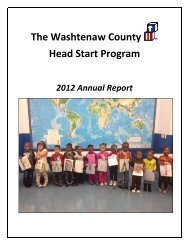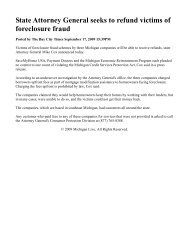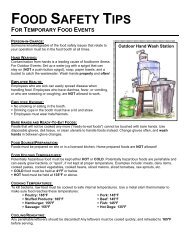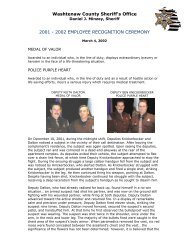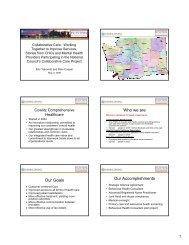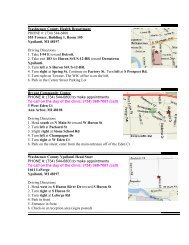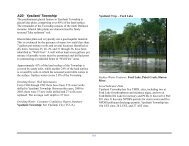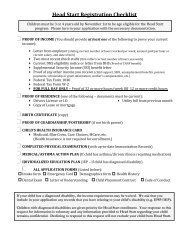Water Protection Activities in Washtenaw County
Water Protection Activities in Washtenaw County
Water Protection Activities in Washtenaw County
Create successful ePaper yourself
Turn your PDF publications into a flip-book with our unique Google optimized e-Paper software.
Activity #16 Natural River Designation<br />
S<strong>in</strong>ce 1970, the Country-Scenic Natural Rivers Designation has<br />
been enabled by the Natural Rivers Act, now known as Part<br />
305 of PA 451 of 1994. The designation was established for the<br />
Huron River from Portage Lake to the Ann Arbor city limits <strong>in</strong><br />
1977. Natural River Designation is <strong>in</strong>tended to preserve the<br />
natural quality of a stream corridor via overlay zon<strong>in</strong>g. It is the<br />
only such designation of this type <strong>in</strong> southeast Michigan. The<br />
townships <strong>in</strong>volved <strong>in</strong> this area of the river are Dexter,<br />
Webster, Scio, and Ann Arbor.<br />
Along this portion of the Huron River homes cannot be built<br />
with<strong>in</strong> 100 feet of the banks, and brush cannot be cut with<strong>in</strong> 25<br />
feet from the banks. Stream cross<strong>in</strong>gs are highly restricted.<br />
More <strong>in</strong>formation regard<strong>in</strong>g Natural River designation can be<br />
found on the Michigan Department of Natural Resources web<br />
site. For more <strong>in</strong>formation visit: www.michigan.gov/dnr<br />
Activity #17 Fish Advisories<br />
The issues surround<strong>in</strong>g fish consumption advisories are<br />
important to understand if you plan on eat<strong>in</strong>g fish from local<br />
water bodies. Low levels of tox<strong>in</strong>s <strong>in</strong> the ambient environment<br />
accumulate <strong>in</strong> fat and muscle tissue of fish. These same tox<strong>in</strong>s<br />
also accumulate <strong>in</strong> people. Some tox<strong>in</strong>s are potentially<br />
hazardous <strong>in</strong> repeated doses, especially <strong>in</strong> young children and<br />
women who may become pregnant.<br />
Certa<strong>in</strong> types of fish found <strong>in</strong> <strong>Washtenaw</strong> <strong>County</strong>, like black<br />
crappie, walleye, channel catfish, large and smallmouth bass,<br />
bullhead, northern pike, white sucker, and carp, may conta<strong>in</strong><br />
elevated levels of tox<strong>in</strong>s, <strong>in</strong>clud<strong>in</strong>g polychlor<strong>in</strong>ated biphenyls<br />
(PCBs) and mercury. These tox<strong>in</strong>s are suspected of caus<strong>in</strong>g<br />
neurological and developmental disorders, cancers, endocr<strong>in</strong>e<br />
disruption, reproductive disorders and other serious health<br />
problems.<br />
42<br />
The Michigan Department of Community Health (MDCH) has<br />
issued a statewide mercury advisory for all <strong>in</strong>land lakes,<br />
reservoirs and impoundments. All of <strong>Washtenaw</strong> <strong>County</strong>’s<br />
lakes are <strong>in</strong>cluded. The general population is advised to limit<br />
consumption of the species <strong>in</strong>cluded <strong>in</strong> the advisory to one<br />
meal per week. Children under age 15 and women of<br />
childbear<strong>in</strong>g age should eat no more than one fish meal per<br />
month. Barton Pond and Ford Lake are the only water bodies <strong>in</strong><br />
the county with advisories for PCBs.<br />
Older and larger fish tend to conta<strong>in</strong> the highest percentages of<br />
tox<strong>in</strong>s and are given an elevated warn<strong>in</strong>g level. By limit<strong>in</strong>g<br />
consumption of high tox<strong>in</strong> fish such as large carp, pike and<br />
catfish, it is safe to <strong>in</strong>clude local fish <strong>in</strong> a diet. People can<br />
protect themselves and their children by:<br />
● Eat<strong>in</strong>g smaller and younger fish.<br />
● Limit<strong>in</strong>g consumption of fish that eat other fish.<br />
● Trimm<strong>in</strong>g and cook<strong>in</strong>g fish <strong>in</strong> ways that reduce the<br />
amount of fat <strong>in</strong>gested.<br />
● Follow<strong>in</strong>g the recommended consumption of fish found<br />
<strong>in</strong> the Michigan Department of Community Health’s<br />
(MDCH) 2004 Fish Consumption Guide. 4<br />
Activity #18 Beach Monitor<strong>in</strong>g<br />
<strong>Washtenaw</strong> <strong>County</strong> Environmental Services Division staff<br />
collects water samples from public beaches throughout the<br />
county from Memorial Day through September. To protect<br />
public health and to prevent the spread of disease, the samples<br />
are analyzed for various water quality parameters, <strong>in</strong>clud<strong>in</strong>g<br />
bacteria levels. Beaches are closed if samples are deemed<br />
unsafe to public health.<br />
4 http://www.michigan.gov/documents/FishAdvisory03_67354_7.pdf


